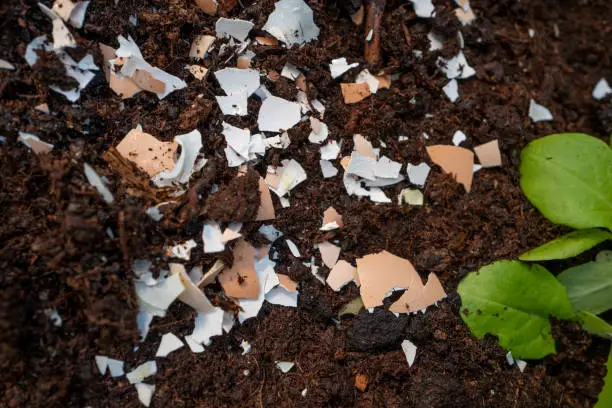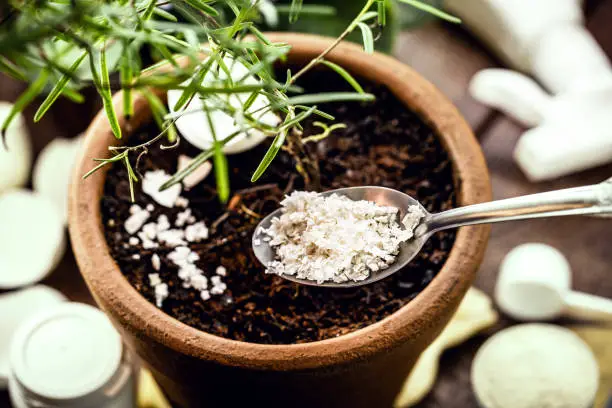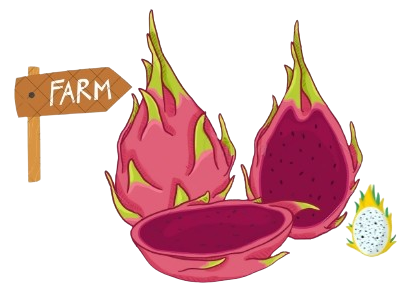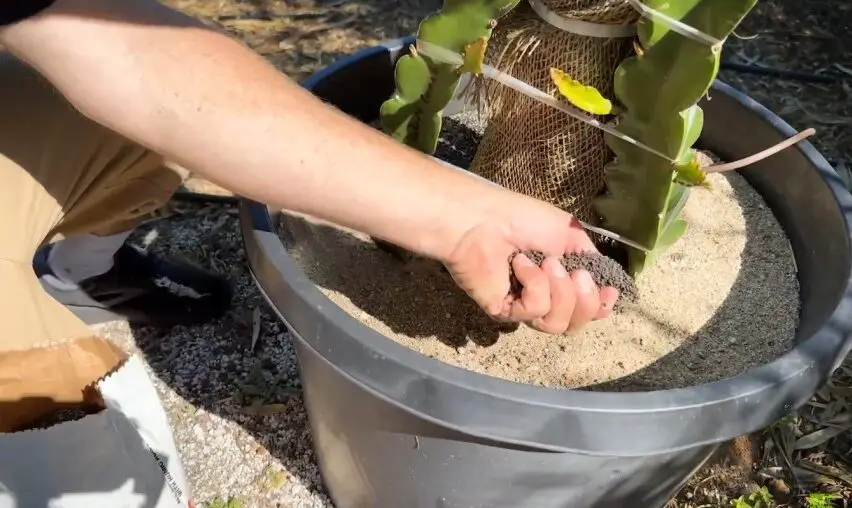Dragon fruit farming is growing worldwide, and to ensure healthy plants and good fruit production, it is essential to provide the right nutrients along with proper water and sunlight. Dragon fruit care tips: Paying attention to proper nutrition is extremely important as this plant requires a specific type of soil and care, and calcium is one of the most essential nutrients. Let’s dive deeper into dragon fruit farming
Ensuring proper nutrition for dragon fruit is crucial as it is considered a heavy feeder. In addition to NPK, it also needs several other important nutrients, and nutrients should be used after carefully considering the benefits and possible harm. Eggshells are one of the easiest and best organic sources for calcium. Let’s explore the benefits and precautions in more detail.
Eggshells as a Calcium Source for Dragon Fruit Care

Calcium in Eggshells
Eggshells are rich in calcium carbonate, which makes up around 95% of their composition. Over time, it dissolves in the soil and provides calcium to plants. Additionally, eggshells contain magnesium, potassium, and some phosphorus, all of which are beneficial for calcium for dragon fruit plants.
Benefits of Eggshells for Dragon Fruit Care
- Natural Option
Eggshells are easily available and provide a cost-effective and sustainable alternative to commercial calcium supplements, making them an excellent choice for dragon fruit farmers. - Improves Soil Structure
Eggshells slowly dissolve and enrich the soil with calcium, which strengthens the roots of plants and improves their overall nutrition, making them beneficial for pitaya plant care as well. - Boosts Disease Resistance
Using organic materials like eggshells helps strengthen the plants, and when the soil has an adequate amount of calcium, the dragon fruit plants become more robust and resistant to diseases like fungal infections and root rot. - Slow Release of Calcium
Eggshells dissolve slowly, ensuring a steady release of calcium into the soil. This helps the plants receive consistent benefits over time, contributing to better dragon fruit plant care.
How to Use Eggshells for Dragon Fruit plant Care
- Dry the Eggshells
First, thoroughly wash the eggshells and dry them under the sun to remove any moisture and eliminate any bacteria that might be present. - Crush Into Small Pieces
Once dried, crush the eggshells into small pieces or grind them into a fine powder using a blender. If a grinder is unavailable, you can crush them manually as well. The powder form helps the calcium dissolve more effectively in the soil, ensuring effective dragon fruit plant care. - Mix with Soil
Mix the prepared eggshell powder with the soil around the dragon fruit plants. You can repeat this process 2-3 times a year to maintain a steady calcium supply, a great practice for pitaya plant care. - Use with Organic Manure
Mixing eggshells with organic fertilizers like cow dung, vermicompost, or other organic compost can increase their effectiveness. This will enhance the nutrient content of the soil, improving dragon fruit health even further.
Things to Keep in Mind
- Avoid Excessive Use
Using too many eggshells can increase the pH of the soil and make it overly alkaline, which may not be suitable for dragon fruit plants. - Limited Use for Alkaline Soil
If your soil is already alkaline, it is better to use eggshells in limited quantities to avoid affecting your pitaya plant care. - Regular Soil Testing
To maintain the balance of calcium, regularly test your soil to ensure its health for the best dragon fruit care.
Calcium Nitrate Spray

What is Calcium Nitrate?
Calcium nitrate (Ca(NO₃)₂) is a water-soluble fertilizer that contains two primary nutrients:
- Calcium (Ca): This strengthens plant cells and improves fruit quality for better dragon fruit plantation care.
- Nitrogen (NO₃): Helps in the green growth of plants and the development of new stems.
Spraying calcium nitrate on the leaves of dragon fruit plants provides a direct supply of calcium to the plants, and it shows faster results compared to applying calcium through the soil.
Benefits of Calcium Nitrate Spray
- Quick Action
When calcium is added to the soil, it takes time for the roots to absorb it, but a foliar spray provides calcium directly to the plant through its leaves, giving quick results for pitaya plant. - Improves Fruit Quality
With the right amount of calcium, dragon fruit becomes larger, stronger, and lasts longer. It also improves the fruit’s shelf life, benefiting dragon fruit . - Increases Growth with Nitrogen
The nitrogen in calcium nitrate promotes the growth of new stems and leaves, making the plant appear healthy and vibrant, which is essential for pitaya plant. - Prevents Blossom End Rot
Calcium nitrate spray can help prevent issues like blossom end rot and cracks in dragon fruit that can occur due to calcium deficiency.
Important Points While Using Calcium Nitrate Spray
- Avoid Overuse
Excessive use of calcium nitrate can burn the leaves due to its hot properties and negatively impact the dragon fruit plant. - Do Not Spray in Direct Sunlight
Spray the solution early in the morning or after 4 PM to avoid the solution evaporating quickly due to the sun, ensuring better pitaya plant. - Avoid Spraying After Rain
If it has rained recently, avoid spraying as the solution will be washed off, and the plant won’t get its full benefit. - Do Not Mix with Other Fertilizers
Avoid mixing foliar spray with other fertilizers, as it may cause chemical reactions, negatively impacting dragon fruit. - Watering After 24 Hours
After spraying, avoid watering the plants for at least 24 hours to allow the plant to absorb the calcium more effectively, aiding pitaya plant care.
Oyster (CP) and Clam Shells for Calcium Supply

If you want a natural and sustainable way to provide calcium to your dragon fruit plants or any other plants, crushed oyster (CP) and clam shells are an excellent organic choice. These shells are not only a source of calcium but also provide other essential nutrients for plants.
Nutrients Found in Crushed Oyster and Clam Shells
- Calcium (Ca): Strengthens plant cells and supports root and stem development for healthier dragon fruit care.
- Magnesium (Mg): Helps in chlorophyll formation for green leaves.
- Phosphorus (P): Vital for root and flower development.
- Trace Minerals: Improve soil fertility and provide balanced nutrition to plants, enhancing pitaya plant care.
Benefits of Crushed Oyster and Clam Shells
- Increases Calcium in Soil
These shells gradually release calcium into the soil, offering long-term benefits. They are particularly useful for acidic soils, promoting better dragon fruit care. - Balances pH Level of Soil
For acidic soils, crushed oyster shells help in balancing the pH, making the soil more plant-friendly and supporting pitaya plant care. - Strengthens Roots and Stems
The calcium strengthens the roots, stems, and leaves, making the plants stronger and improving their productivity, essential for dragon fruit care. - Encourages Beneficial Soil Microorganisms
Organic materials like these shells help activate beneficial microorganisms in the soil, improving soil fertility and structure, which is important for dragon fruit plants.
FAQs
Q1: Can these calcium sources be used for other plants as well?
Yes, all of these calcium sources can be used for other types of gardening or vegetables, and they are beneficial for dragon fruit as well.
Q2: How often should dragon fruit receive calcium in a year?
It is a good practice to add calcium every time you add fertilizer. You can provide calcium twice a year. The advantage of organic calcium sources is that they gradually release calcium throughout the year, promoting healthy dragon fruit plants.
Q3: When do dragon fruit plants require the most calcium?
The plants need more calcium during the fruiting phase. Therefore, make sure your plants have enough calcium before that time for optimal dragon fruit.
If you have any question, drop a comment down below.


1 thought on “3 Simple Ways to Add Calcium to Your Dragon Fruit Care”